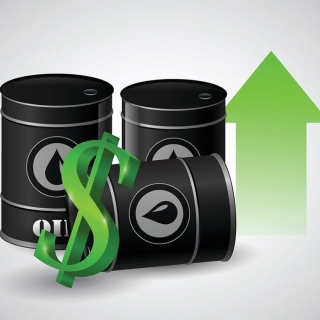


Oil prices were volatile on Monday, after jumping 7% on Friday, as fresh attacks by Israel and Iran over the weekend raised concerns that fighting could spread across the region and significantly disrupt oil exports from the Middle East.
Brent crude futures rose 64 cents, or 0.86%, to $74.87 a barrel by 0507 GMT, while U.S. West Texas Intermediate crude rose 76 cents, or 1.04%, to $73.74. Oil prices had jumped more than $4 a barrel earlier in the session and also briefly dipped into negative territory.
Both benchmarks closed 7% higher on Friday, after jumping more than 13% during the session to their highest levels since January. Iranian missiles struck Tel Aviv, Israel, and the port city of Haifa on Monday, destroying homes and raising concerns among world leaders at this week's G7 meeting that fighting between the old foes could lead to a wider regional conflict.
Exchanges of fire between Israel and Iran on Sunday resulted in civilian casualties, with both militaries urging civilians on the opposing side to take precautions against further attacks.
The latest developments have raised concerns about disruptions in the Strait of Hormuz, a vital shipping lane. About a fifth of the world's total oil consumption, or about 18 to 19 million barrels per day (bpd) of oil, condensate and fuel, passes through the strait.
"Buying was driven by the ongoing Israel-Iran conflict, with no resolution in sight," said Toshitaka Tazawa, an analyst at Fujitomi Securities.
"But as seen last Friday, some of the selling came on concerns about overreaction," he said. While the market is watching for potential disruptions to Iranian oil production from Israeli attacks on energy facilities, growing concerns over a blockade of the Strait of Hormuz could push prices up sharply, Tazawa added.
Iran, a member of the Organization of the Petroleum Exporting Countries (OPEC), currently pumps about 3.3 million barrels of oil per day and exports more than 2 million barrels of oil and fuel per day.
The spare capacity of OPEC and its allies, including Russia, to pump more oil to offset any disruptions is roughly equivalent to Iran's production, according to analysts and OPEC watchers.
"If Iranian crude exports are disrupted, Chinese refiners, the sole buyers of Iranian crude, will need to look for alternative oil grades from other Middle Eastern countries and Russian crude," Richard Joswick, head of short-term oil analysis at S&P Global Commodity Insights, said in a note.
"This could also increase freight rates and tanker insurance premiums, narrowing Brent-Dubai spreads and hurting refinery margins, particularly in Asia," Joswick added.
US President Donald Trump said on Sunday he hoped Israel and Iran could broker a ceasefire, but added that sometimes countries have to fight first. Trump said the US would continue to support Israel but declined to say whether he had asked the US ally to halt its attacks on Iran.
German Chancellor Friedrich Merz said he hoped a meeting of Group of Seven leaders meeting in Canada on Sunday would reach a deal to help resolve the conflict and prevent it from escalating.
Meanwhile, Iran has told mediators Qatar and Oman that it is not open to negotiating a ceasefire while under Israeli attack, an official briefed on the communications told Reuters on Sunday. (alg)
Source: Reuters
Oil prices were little changed despite news that OPEC+ plans to end its supply increases, with the market weighed down by concerns about oversupply and weak factory data in Asia. Brent crude futures ...
Oil prices rose in early Asian trading after OPEC and its allies (OPEC+) agreed to increase production by 137,000 barrels per day in December. Despite the increase, the group stated that it would not ...
Oil prices headed for a third straight monthly decline, falling on Friday (October 31st) due to a stronger US dollar, weak Chinese data, and rising supply from major global producers. Brent crude fut...
Oil headed for a third monthly drop on concerns about a global glut, with OPEC+ expected to back another supply hike this weekend. West Texas Intermediate fell toward $60 a barrel, on track for ...
Oil prices fell on Thursday (October 30th) as investors assessed the potential for a truce in the trade dispute between the United States and China. President Donald Trump lowered tariffs on China aft...
The economic activity in the United States' (US) manufacturing sector continued to contract in October, with the Institute for Supply Management's (ISM) Manufacturing Purchasing Managers' Index (PMI) dropping to 48.7 from 49.1 in September. This...
The S&P 500 rose on Monday, led by tech, as a new month of trading began. The benchmark gained 0.5%, while the Nasdaq Composite advanced 1%. The Dow Jones Industrial Average climbed 18 points. Micron Technology gained 5% to lead chipmaker...
Gold prices held near $4,000 an ounce after a weak start on Monday, as China ended long-standing tax breaks for some retailers. This change could weigh on demand in one of the world's largest precious metals markets. Gold bullion prices for...

 The Nasdaq Composite rose 0.7% and the S&P 500 gained 0.3% on Friday, led by a 10.8% surge in Amazon shares after the company said cloud revenue...
The Nasdaq Composite rose 0.7% and the S&P 500 gained 0.3% on Friday, led by a 10.8% surge in Amazon shares after the company said cloud revenue...
 European stocks opened slightly higher in November, with the STOXX 50 and STOXX 600 gaining 0.2%, after closing near record highs in October....
European stocks opened slightly higher in November, with the STOXX 50 and STOXX 600 gaining 0.2%, after closing near record highs in October....
 As the U.S. government shutdown disrupts federal employee paychecks across the country, it also exacerbates the financial hardship of attorneys who...
As the U.S. government shutdown disrupts federal employee paychecks across the country, it also exacerbates the financial hardship of attorneys who...